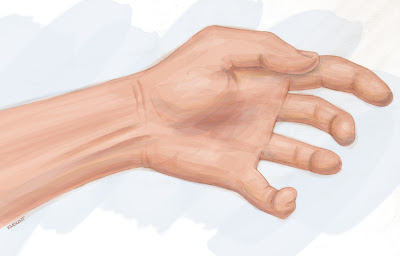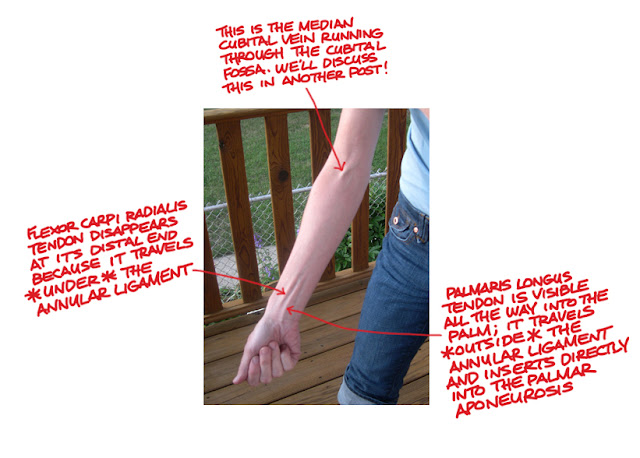But the distal end of the ventral forearm (the end closest to the wrist) does have a few prominent surface landmarks. I write "a few" instead of a specific number because the number depends on the individual; one of the tendons that's often seen at this location comes from a muscle that is actually missing in 12-15% of the human population! And, if that muscle and tendon are missing, some deeper tendons may or may not show!
Let's back up a little. In most cases, there are two fairly visible tendons down the approximate center of the ventral wrist. (Their degree of visibility also depends on genetics, hand position, and temporary body variations such as those seen in water retention.) Those two tendons come from the palmaris longus muscle and the flexor carpi radialis muscle. They are shown in the illustration below. We can tell this is a ventral view of the forearm because we can see the palmar aponeurosis (a thin, tendinous sheath that is only on the palmar side of the hand) and because, um... there are no fingernails!
If both the flexor carpi radialis tendon and the palmaris long tendon are visible, it's easy to tell one from the other; the flexor carpi radialis tendon is more toward the radial (thumb) side of the arm, as its name implies. Once that's been established, one can deduce that the other tendon is most likely that of palmaris longus.
The palmaris longus tendon is also more superficial than the flexor carpi radialis tendon because it runs outside the annular ligament, while all the other wrist tendons run deep to it. The annular ligament is a ring-like ligament ("annular" is Latin for "ring-like") that wraps around the wrist like a bracelet and retains the position of the tendons that run from the forearm and into the hand. After surpassing the annular ligament, the palmaris longus tendon inserts directly into the palmar aponeurosis and tenses it to help strengthen the grip.
In some cases, one or both of these tendons are difficult to see, especially when the hand is relaxed. Because both of these muscles are flexors, you can force them to stand out more by flexing the wrist and tensing the hand into sort of a claw shape.
In the photo below, you can easily see both ventral forearm tendons and tell them apart. First of all, flexor carpi radialis is the more radial of the two (meaning it is closer to the thumb side.) Second, palmaris longus can be seen more clearly where the wrist meets the hand, because at that point, flexor carpi radialis is traveling under the annular ligament and palmaris longus is not.
But because palmaris longus is missing in 12 to 15% of the human population, we must also consider what the wrist looks like if there is no palmaris longus muscle. If the palmaris longus muscle is missing, you can usually still see the tendon of flexor carpi radialis. Ulnar to that, where the palmaris longus tendon would normally be seen, you might see nothing but smooth skin. Or you may see some less pronounced tendons, which would most likely be those of flexor digitorum superficialis, which lies deep to everything we've talked about so far. Flexor digitorum superficialis is Latin for "superficial flexor of the fingers," which implies there is also a deep flexor of the fingers (flexor digitorum profundus.) But that muscle is very deep and there is usually no evidence of it on the surface.
In my Anatomy class at the American Academy of Art in Chicago, we always end week 11 ("forearm week") with all my students making claw hands and checking to see whether they have the palmaris longus muscle. As expected, most students have it, a few don't, and occasionally one or two have palmaris longus in one forearm but not the other. But there is one occurrance of which I've found I can be almost 100% sure: Those students who do not have the palmaris longus tendon always seem bothered by this fact, and some actually refer to themselves as freaks! Let's make this clear once and for all: You are not a freak if you don't have the palmaris longus muscle! Distinctive, yes, but not a freak.
Do you have the palmaris longus muscle? See if you can tell and let me know. I welcome your photos, comments, and questions!
Until next time,
Kristin



When you say "missing" - You mean it's literally not there? Or just not visible?
ReplyDeleteThis has instantly become one of my favorite blogs.
It's not there! Clearly it's not a muscle that is essential to survival. Most who don't have it never realize that fact until some strange anatomy teacher suggests they look for it. Its purpose is just to tense the palmar aponeurosis to help with the grip, but because we can grip fine with out it, its absence isn't noticeable. I suppose if an individual had *had* the palmaris longus all along and then lost it, he or she might notice a difference. But you are born either with it or without it.
ReplyDeleteFreaky!...I mean distinctivey!
ReplyDeleteI do have the palmaris longus tendon, but I found an image online of someone who lacks it. I will email it to you.
ReplyDeleteI remember being obsessed with the very prominent tendons on Michael Jackson's arm in his photo on the "Thriller" album when I was kid. I thought he was super hot but his arms were gross.
ReplyDeleteNice tendons, but that's the dorsal side of his hand showing; those are the tendons of his extensor digitorum muscle. This area is very cool, so I will definitely have to have a post about it soon. And Michael's photo might come up again when I write about nose anatomy...
ReplyDeleteI do not have a palmaris longus tendon in my right arm. How can I email you a picture?
ReplyDeleteThis comment has been removed by the author.
ReplyDeleteYes, please do. You can send it to mount@uic.edu
ReplyDeleteDoes any body else gave three visible tendons in their wrist? The most I can find on the internet is two.
ReplyDeleteThis comment has been removed by the author.
DeleteI missed this, and I'm sorry it took me so long to answer. Yes, sometimes a tendon or two of a deeper muscle, flexor digitorum superficialis, will also show. If one of those tendons shows, plus those of flexor carpi ulnaris and palmaris longus, you'll see three! If you want to send me a photo, I'll label it and add it to this post.
Delete